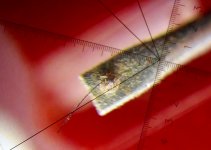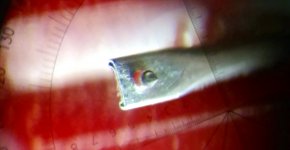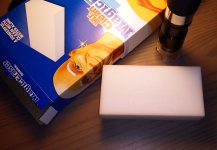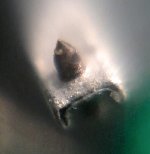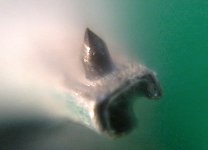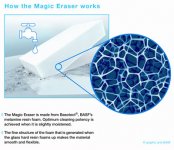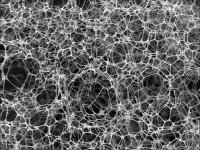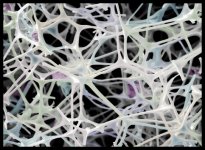It seems everyone already knows this, except me, it seems.
I am a believer now.
I'm putting this up so other newbs like me can see the benefit from such an easy way to clean.
I used the cut "Mr Clean" "MagicEraser" ... it's a white soft sponge that I cut to 1/4" x 1/2" x 1/2" glued to a quarter, placed on the TT platter, using the cuing lever to drop the stylus 3 time(yes I only did 3 times) onto the magicEraser. I'm putting this up as I was amazed at the results.
How I got here.
Getting back into analog after 30+ years of being away from it.
Bought a 70's era CEC/realistic/ TT off ebay.
It had some mechanical issues, fixed those, the sound was pretty decent out of the included un marked stylus so I decided to keep it for now.
I wanted to take a look at it(stylus) to make sure it actually did have a stylus and that it was in somewhat decent shape and I wasn't just carving vinyl as I played my new/old records.
this lead me to find a way to take a look at the stylus with something better than my aging eyes. I found "surplus shed" and they had a $40 microscope
HIGH QUALITY MONOCULAR/MICROSCOPE WITH COMPLEX RETICLE - Surplus Shed
I used my cell phone to capture the pics looking through the microscope, they are little blurry but one can get an idea of the before and after.
Based on the shape of the dirty needle I found when I had a look at it, I was planning to need to do the cuing plunge a dozen or so times, thus my surprise at only needing the 3 dips.
In the dirty pic one can see a 'carbon' fiber attached to the stylus I suspect from my new record cleaner "DA Mark 6 Carbon Fiber Record Brush" .... looks like I need to find something better than that piece of hughy ...
The folks that discovered and promoted the magicEraser method I need to thank. No fluids and no stress on the stylus.
I am a believer now.
I'm putting this up so other newbs like me can see the benefit from such an easy way to clean.
I used the cut "Mr Clean" "MagicEraser" ... it's a white soft sponge that I cut to 1/4" x 1/2" x 1/2" glued to a quarter, placed on the TT platter, using the cuing lever to drop the stylus 3 time(yes I only did 3 times) onto the magicEraser. I'm putting this up as I was amazed at the results.
How I got here.
Getting back into analog after 30+ years of being away from it.
Bought a 70's era CEC/realistic/ TT off ebay.
It had some mechanical issues, fixed those, the sound was pretty decent out of the included un marked stylus so I decided to keep it for now.
I wanted to take a look at it(stylus) to make sure it actually did have a stylus and that it was in somewhat decent shape and I wasn't just carving vinyl as I played my new/old records.
this lead me to find a way to take a look at the stylus with something better than my aging eyes. I found "surplus shed" and they had a $40 microscope
HIGH QUALITY MONOCULAR/MICROSCOPE WITH COMPLEX RETICLE - Surplus Shed
I used my cell phone to capture the pics looking through the microscope, they are little blurry but one can get an idea of the before and after.
Based on the shape of the dirty needle I found when I had a look at it, I was planning to need to do the cuing plunge a dozen or so times, thus my surprise at only needing the 3 dips.
In the dirty pic one can see a 'carbon' fiber attached to the stylus I suspect from my new record cleaner "DA Mark 6 Carbon Fiber Record Brush" .... looks like I need to find something better than that piece of hughy ...
The folks that discovered and promoted the magicEraser method I need to thank. No fluids and no stress on the stylus.
Attachments
One should be cautious about using everything on a stylus to clean the diamond. The reason is that while you may be making it clean now, in the future the residual and the actual stuff at the time may have a deleterious effect upon the bonding agent that is holding the stylus to the cantilever.
In the case of aluminum cantilevers, one could cause corrosion which can embrittle and eventually cause the destruction of the cantilever.
Sometimes this can take many years. In the case of a very good and expensive cartridge, that may be a problem down the road. For an inexpensive cartridge, maybe nothing to worry about.
I've had this long term problem happen in a number of circumstances and for a number of reasons.
PS. wonder what is the active ingredient(s) in the magic eraser product.
In the case of aluminum cantilevers, one could cause corrosion which can embrittle and eventually cause the destruction of the cantilever.
Sometimes this can take many years. In the case of a very good and expensive cartridge, that may be a problem down the road. For an inexpensive cartridge, maybe nothing to worry about.
I've had this long term problem happen in a number of circumstances and for a number of reasons.
PS. wonder what is the active ingredient(s) in the magic eraser product.
what is the active ingredient(s) in the magic eraser product.
The only active ingredient listed is melamine polymer.
Nothing but friction and contact - how cool!
From 'How Stuff Works' -
Erasing Stains with Melamine Foam
Magic Erasers, Easy Erasing Pads and similar products all have the same key ingredient: melamine foam. Melamine foam erasers are formed differently from other cleaning products and only need water to effectively clean most stains -- no chemical cleaners or soaps required. The only downfall is that melamine foam erasers wear out quickly -- just like pencil erasers do.
To all outward appearances, however, melamine foam erasers look and feel just like any other sponge. To view the crucial properties of melamine foam, you need to go down to the microscopic level. This is because when melamine resin cures into foam, its microstructure becomes very hard -- almost as hard as glass -- causing it to perform on stains a lot like super-fine sandpaper. You may be asking yourself, if this foam is almost as hard as glass, then how can it be like a sponge? Because it's a special type of open-cell foam.
Closed-cell foam is easier to visualize, so let's start there. Types of closed-cell foam are usually the more rigid because they retain most of their air pockets intact, like a bunch of balls all crammed together. For open-cell foam (typically the more flexible) imagine that those balls have burst, but that some sections of their casings still remain. You can picture a squishy sea sponge as an example. In airy melamine foam, only a very limited amount of casing stays in place, and the strands that do are located where the edges of several air pockets overlapped. The foam is flexible because each tiny strand is so slender and small that bending the entire eraser is easy.
**The cavity-ridden open microstructure of melamine foam is where the second major boost to its stain-removing capabilities comes in. Apart from being able to scrape at stains with extremely hard microscopic filaments, with a few quick runs of the eraser, the stain has already started to come away. That's aided by the fact that the dirt is pulled into the open spaces between the spindly skeletal strands and bound there. These two factors combined make this next-generation eraser seem almost magical.
From 'How Stuff Works' -
Erasing Stains with Melamine Foam
Magic Erasers, Easy Erasing Pads and similar products all have the same key ingredient: melamine foam. Melamine foam erasers are formed differently from other cleaning products and only need water to effectively clean most stains -- no chemical cleaners or soaps required. The only downfall is that melamine foam erasers wear out quickly -- just like pencil erasers do.
To all outward appearances, however, melamine foam erasers look and feel just like any other sponge. To view the crucial properties of melamine foam, you need to go down to the microscopic level. This is because when melamine resin cures into foam, its microstructure becomes very hard -- almost as hard as glass -- causing it to perform on stains a lot like super-fine sandpaper. You may be asking yourself, if this foam is almost as hard as glass, then how can it be like a sponge? Because it's a special type of open-cell foam.
Closed-cell foam is easier to visualize, so let's start there. Types of closed-cell foam are usually the more rigid because they retain most of their air pockets intact, like a bunch of balls all crammed together. For open-cell foam (typically the more flexible) imagine that those balls have burst, but that some sections of their casings still remain. You can picture a squishy sea sponge as an example. In airy melamine foam, only a very limited amount of casing stays in place, and the strands that do are located where the edges of several air pockets overlapped. The foam is flexible because each tiny strand is so slender and small that bending the entire eraser is easy.
**The cavity-ridden open microstructure of melamine foam is where the second major boost to its stain-removing capabilities comes in. Apart from being able to scrape at stains with extremely hard microscopic filaments, with a few quick runs of the eraser, the stain has already started to come away. That's aided by the fact that the dirt is pulled into the open spaces between the spindly skeletal strands and bound there. These two factors combined make this next-generation eraser seem almost magical.
Though not intended for cleaning techniques, here are some interesting closeup with magic eraser. Stylus closeups
Below are mine with mobile camera and cd player lens. Was taken with quick and dirty jig setup and pictures little enhanced.
Regards.
Below are mine with mobile camera and cd player lens. Was taken with quick and dirty jig setup and pictures little enhanced.
Regards.
Attachments
wow, super cool!
But the hardness of melamine is very low?
So, it's more than a super fine abrasive, it's super fine AND super soft (as things go).
I'm surprised about this, since they advertise it for removing marker from surfaces.
Going to have to experiment with this stuff.
What does it do to paint?
Is it softer than paint??
Cool stuff. Tnx for the rundown!
But the hardness of melamine is very low?
So, it's more than a super fine abrasive, it's super fine AND super soft (as things go).
I'm surprised about this, since they advertise it for removing marker from surfaces.
Going to have to experiment with this stuff.
What does it do to paint?
Is it softer than paint??
Cool stuff. Tnx for the rundown!
I also have been cleaning my stylus using this method and also found that it works great .
Personally, when doing this, I also use a lighted head mounted magnifier that I had on hand (for plastic model aircraft building) and it comes in handy for lot of things .
Anyway, the fibers' cross sections in a "magic eraser' are not round, they are angular.
The combo of the random arrangement and angular nature of the fibers is what makes it "clean" things and......gently grabs onto debris on a stylus..
BTW for our use, it must be used dry and never moistened as this changes the fiber's structure .
Personally, when doing this, I also use a lighted head mounted magnifier that I had on hand (for plastic model aircraft building) and it comes in handy for lot of things .
Anyway, the fibers' cross sections in a "magic eraser' are not round, they are angular.
The combo of the random arrangement and angular nature of the fibers is what makes it "clean" things and......gently grabs onto debris on a stylus..
BTW for our use, it must be used dry and never moistened as this changes the fiber's structure .
Last edited:
why does it need glueing to anything?
Just a convenience thing, mine are just little blocks that get lost periodically.. lol (It is pretty light stuff)
- Status
- This old topic is closed. If you want to reopen this topic, contact a moderator using the "Report Post" button.
- Home
- Source & Line
- Analogue Source
- Magic Eraser on old ebay stylus - amazing
